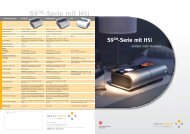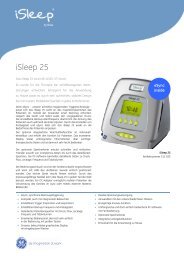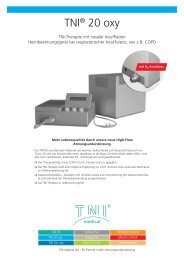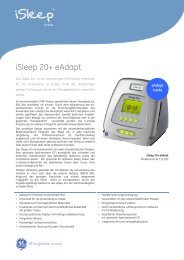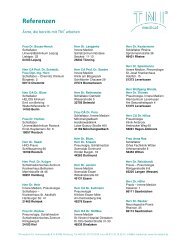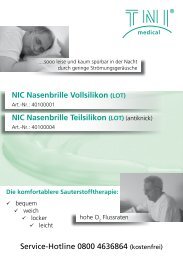Download Product catalogue - TNI medical AG
Download Product catalogue - TNI medical AG
Download Product catalogue - TNI medical AG
Create successful ePaper yourself
Turn your PDF publications into a flip-book with our unique Google optimized e-Paper software.
<strong>TNI</strong> ® Studies<br />
44<br />
Therapy<br />
A Nasal Cannula Can Be Used to Treat Obstructive<br />
Sleep Apnea<br />
Brian M. McGinley 1 , Susheel P. Patil 1 , Jason P. Kirkness 1 , Philip L. Smith 1 , Alan R. Schwartz 1 , and<br />
Hartmut Schneider 1<br />
Diagnostics<br />
1 JohnsHopkinsSleepDisordersCenter,DivisionofPulmonaryandCriticalCareMedicine,JohnsHopkinsUniversity,Baltimore,Maryland<br />
Rationale: Obstructive sleep apnea syndrome is due to upper airway<br />
obstruction and is associated with increased morbidity. Although<br />
continuous positive airway pressure efficaciously treats obstructive<br />
apneas and hypopneas, treatment is impeded by low adherence<br />
rates.<br />
Objectives: To assess the efficacy on obstructive sleep apnea of a<br />
minimally intrusive method for delivering warm and humidified air<br />
through an open nasal cannula.<br />
Methods: Eleven subjects (age, 49.7 � 5.0 yr; body mass index, 30.5 �<br />
4.3 kg/m 2 ), with obstructive apnea–hypopnea syndrome ranging<br />
from mild to severe (5 to 60 events/h), were administered warm<br />
and humidified air at 20 L/minute through an open nasal cannula.<br />
MeasurementsandMainResults: Measurements were based on standard<br />
sleep-disordered breathing and arousal indices. In a subset<br />
of patients pharyngeal pressure and ventilation were assessed to<br />
determine the mechanism of action of treatment with nasal insufflation.<br />
Treatment with nasal insufflation reduced the mean apnea–<br />
hypopnea index from 28 � 5 to 10 � 3 events per hour (p � 0.01),<br />
and reduced the respiratory arousal index from 18 � 2 to 8 � 2<br />
events per hour (p � 0.01). Treatment with nasal insufflation reduced<br />
the apnea–hypopnea index to fewer than 10 events per hour<br />
in 8 of 11 subjects, and to fewer than 5 events per hour in 4 subjects.<br />
The mechanism of action appears to be through an increase in<br />
end-expiratory pharyngeal pressure, which alleviated upper airway<br />
obstruction and improved ventilation.<br />
Conclusions: Our findings demonstrate clinical proof of concept that<br />
a nasal cannula for insufflating high airflows can be used to treat<br />
a diverse group of patients with obstructive sleep apnea.<br />
Keywords:treatmentwithnasalinsufflation,<strong>TNI</strong>;pharyngealpressure<br />
Obstructive sleep apneasyndrome is duetoupper airwayobstruction<br />
leading to intermittent hypoxemia, sleep fragmentation,metabolicdysfunction(1,2),andincreasedcardiovascular<br />
morbidity and mortality (3, 4). Current treatment options, includingcontinuouspositiveairwaypressure(5),oralappliances<br />
(6),andsurgicalprocedures(7),areoftenintrusiveorinvasive,<br />
and not well tolerated, leaving a vast number of subjects untreated<br />
(8, 9). Therefore, improved therapeutic strategies are<br />
requiredtotreatsleepapneasandhypopneasandtheirassociatedmorbidityandmortality.Upperairwayobstructionisduetoincreasedpharyngealcollapsibility(10–12),whichdecreasesinspiratoryairflowasmanifested<br />
by snoring andobstructive hypopneasand apneas (13).<br />
This defect in upper airway collapsibility can be overcomeby<br />
elevatingnasalpressure.Infact,somewhatgreaterlevelsofnasal<br />
(ReceivedinoriginalformSeptember18,2006;acceptedinfinalformMarch14,2007)<br />
SupportedbyHL-72126,HL-50381,HL-37379,HL-077137,NHMRC-353705,<br />
andSeleonGmbH,Germany.<br />
Correspondence and requests for reprints should be addressed to Hartmut<br />
Schneider,M.D.,Ph.D.,JohnsHopkinsAsthmaandAllergyCenter,5501Hopkins<br />
BayviewCircle,Room4B47,Baltimore,MD21224.E-mail:hschneid@jhmi.edu<br />
Am J Respir Crit Care Med Vol 176. pp 194–200, 2007<br />
Originally Published in Press as DOI: 10.1164/rccm.200609-1336OC on March 15, 2007<br />
Internet address: www.atsjournals.org<br />
AT A GLANCE COMMENTARY<br />
Scientific Knowledge on the Subject<br />
Highlevelsofcontinuouspositiveairwaypressure(CPAP)<br />
areneededtoalleviateobstructiveapneas;lowcompliance<br />
withCPAPimpedesitstherapeuticeffectiveness;and,becausehypopneascanbetreatedwithlowlevelsofCPAP,nasalinsufflationofairmighteffectivelytreatmildobstructivesleepapnea.<br />
What This Study Adds to the Field<br />
Nasalinsufflation canprovide distinctclinicaladvantages<br />
overCPAPforasubstantialproportionofthepatientpopulationwithsleepapnea.<br />
pressure are required to abolish apneas than hypopneas, and<br />
to restore normal levels of inspiratory airflow (12, 14). Thus,<br />
minimallyintrusivemethodsfordeliveringlowlevelsofairway<br />
pressuremayberemarkablyeffectiveintreatinghypopneas.<br />
At present, continuous positive airway pressure (CPAP) is<br />
most effective in eliminating apneas and hypopneas, although<br />
long-termeffectivenessiscompromisedbylowadherencethat<br />
is estimated at only 50 to 60% (15, 16). Poor adherence has<br />
beenattributedtothesideeffectsassociatedwithnasalCPAP,<br />
includingdifficultytoleratingpressureandthenasalmaskinterface,nasal<br />
irritation, claustrophobia, andskin breakdown (17,<br />
18).Toaddresstheseissues,wedevelopedasimplifiedmethod<br />
forincreasingpharyngealpressurebydeliveringwarmandhumidifiedairatacontinuoushighflowratethroughanopennasal<br />
cannula.Thepresentstudywasdesignedtodeterminewhether<br />
treatment with nasal insufflation (<strong>TNI</strong>) alleviates obstructive<br />
sleepapneaandhypopneaacrossaspectrumofdiseaseseverity.<br />
Some of the results of these studies have been previously reportedintheformofabstracts(19,20).<br />
METHODS<br />
Participants<br />
SubjectswererecruitedfromtheJohnsHopkinsSleepDisordersCenter<br />
(Johns Hopkins University, Baltimore, MD) if they had more than<br />
fiveobstructivedisorderedbreathingepisodesperhourofsleepona<br />
standardovernightpolysomnogram.Patientswereselectedtoprovide<br />
abalancedrangeofdiseaseseverityencompassingaspectrumofmild<br />
(apnea–hypopnea index [AHI] � 5–15 events/h, n � 3), moderate<br />
(AHI,15–30events/h,n�5),andsevere(AHI �30events/h,n�3)<br />
sleep apnea (Table 1), withacomparable mixof sex and body mass<br />
index.SevenpatientswerereceivingCPAP,fourofwhom(subjects3,<br />
6, 9, and 10) participated in the study because they had difficulties<br />
toleratingCPAP,withcompliancedefinedasCPAPusefor4hoursor




